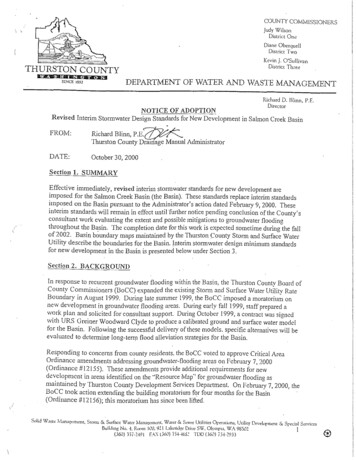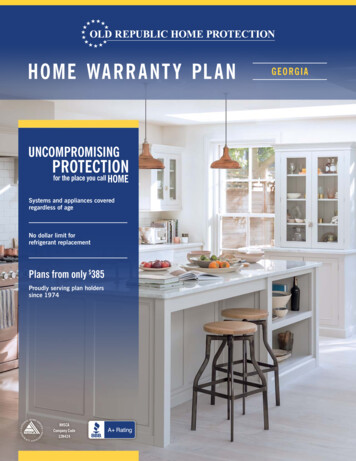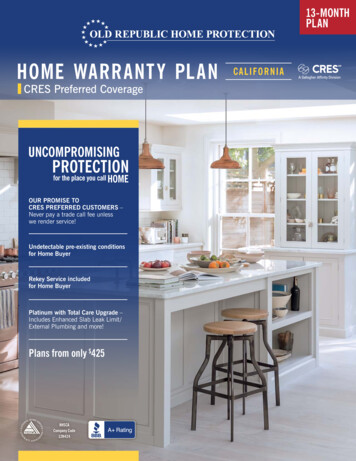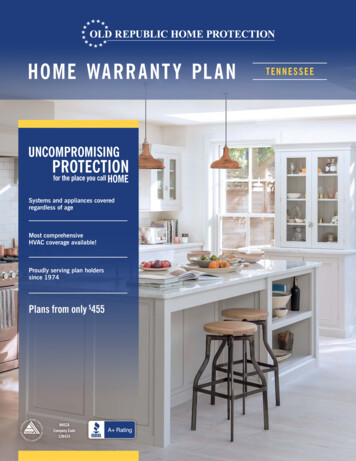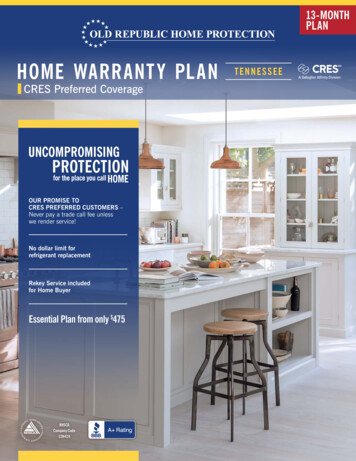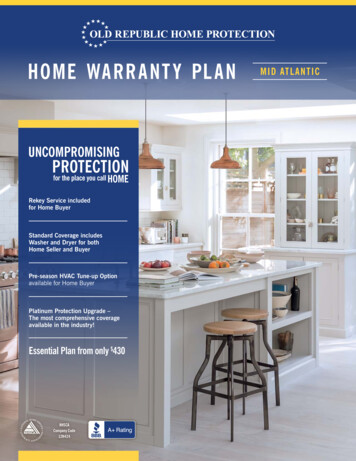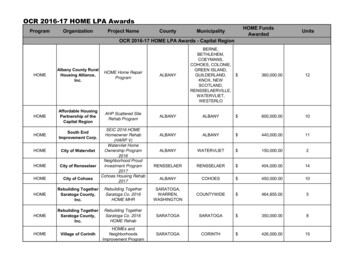
Transcription
Protect Your Homefrom FloodingLOW-COST PROJECTS YOU CAN DO YOURSELF
FLOODING IS THE MOST COMMON AND COSTLY DISASTERIN THE UNITED STATES AND CAN HAPPEN ANYWHERE.However, there are many ways to reduce your home’s risk of flooding,and not all of them are difficult or expensive. This guide briefly describessome of the smaller, lower cost actions you can take yourself or with minorassistance from others. It also suggests places you can go to find moreinformation about flood mitigation techniques, including some of these.You have many flood mitigation options as a homeowner. As you beginto think about which might be the best for you and your home, considerfollowing these three key steps:1. Know Your Risk. Anywhere it can rain, it can flood–so we all live in aflood zone, and we all live with the risk of flood damage to our property. Learnmore details about your home’s level of flood risk, including the type of floodzone it is in and, if available, the potential flood elevation (referred to as the“base flood elevation” on a flood map). A good place to start is FEMA’s onlineFlood Map Service Center at www.msc.fema.gov/portal/. You can also visit theofficials in your community who maintain the FEMA flood maps and elevationcertificates; they may work in the local planning and zoning office or in thebuilding department. Talk to them, your neighbors, and others about any pastflood events and how high the water has risen in the past at or near your home.2. Insure Your Property. As a homeowner, it’s important to insure your homeand personal belongings. Even if your home is in a low- or moderate-risk floodzone, purchasing a flood insurance policy is highly recommended. It providesyou with financial protection from a flood event. Flood damage isn’t covered bystandard homeowners insurance policies, and just a few inches of floodwatercan end up costing thousands of dollars in repairs. More than 25 percentof flood insurance claims come from properties that are not in an identifiedhigh-risk zone, but most homeowners in these areas are eligible for coverageat a preferred rate. Preferred Risk Policy premiums are the lowest premiumsavailable, offering building and contents coverage for one low price.3. Reduce Your Risk. Decide how to prepare your family and protect yourhome from flooding. Consider which of the methods included in this guide aremost appropriate and practical, based on your home’s flood risk, and createa plan to mitigate the risk to your property. Even after a mitigation project,some risk will remain, so learn about more actions to prepare and protectyour family, home, and belongings at www.ready.gov/make-a-plan.
Please be aware that flood mitigation measures need to betailored to the property in question. Depending on the project,you may need to consult local architects, engineers, contractors,landscapers, or other experts in design and construction. Also,changes to properties and buildings often require permits or otherregulatory approvals. Your local planning and zoning office orbuilding department is a good place to start for advice on how tobest proceed. Lastly, please remember to be kind to your neighbors!Consulting adjacent property owners is very important whenany actions on your property, such as extending downspouts orregrading areas between homes, could affect their property.OUTSIDE THE HOMEFor the exterior areas of your property, consider taking thefollowing actions: Maintain proper water runoff and drainage. Routinely clean andmaintain gutters, downspouts, and splashpads so that rainwater from yourroof flows easily away from your home. Also, make sure that any nearbydrainage ditches or storm drains are clear of debris and functioningproperly. Improve lot grading. Determine how water flows or accumulatesaround your home to identify potential trouble spots (often easy to seeduring an average rainstorm). Stormwater should always drain away fromthe building; if necessary, change your landscaping to improve runoff.This may include building up any sunken areas around the foundation,digging small depressions to properly channel water, and otherwiseimproving the yard so that it slopes away from your home. Reduce impervious surfaces around your home. Water runs offconcrete and asphalt almost immediately and can exceed the capacityof storm sewers quickly during heavy rains. Retaining and creatingnatural green space around your home can help reduce sewer overflowsby reducing stormwater runoff. Consider options such as rain gardens,vegetated swales, or pervious pavements, which allow more water to beabsorbed by the ground. Install a rain barrel. A rain barrel is an alternative method fordealing with rainwater. Rain barrels are typically connected to gutterdownspouts and collect the runoff from roofs. You can use this storedwater for non-potable uses such as watering the lawn and gardens orwashing your car. Elevate utilities and service equipment. Raise and anchor airconditioning condensers, heat pumps, water meters and other serviceequipment onto pedestals or platforms that are at least 1 foot abovethe potential flood elevation. For identified high-risk zones this meansgoing to or above the regulatory flood elevation for the property asadopted by the local community. This inexpensive action can helpprevent significant damage and disruption following a flood event. Anchor outdoor fuel tanks. Attach outdoor fuel tanks to a largeconcrete slab that weighs enough to resist the force of floodwaters,or install inexpensive ground anchors that are connected acrossthe top of the tank with metal straps. Unanchored fuel tanks can beeasily moved and ruptured by floodwaters and pose serious threats topeople, property, and the environment. If located in an identified highrisk zone, fuel tanks should also be elevated to or above the regulatoryflood elevation as adopted by the local community. If not feasible thenall filling and ventilation tubes should be elevated so that floodwaterscannot enter the tank.
INSIDE THE HOMEFor interior areas below the potential flood elevation, considermaking the following alterations: Protect your valuable possessions. Move important documents andother valuable or sentimental items to a safer location, well above thepotential flood elevation and/or inside watertight containers. Seal your foundation and basement walls. Close any foundationcracks with mortar and masonry caulk or hydraulic cement, whichexpands and fills gaps completely. Seal walls in your basements withwaterproofing compounds to avoid seepage. Make sure any floor drainsare clear of obstructions. Install flood vents. Flood vents are small permanent openings thatallow floodwater to flow freely through an enclosure such as a crawlspaceor garage. Properly positioned and installed flood vents protect homesduring floods by preventing water pressure buildup that can destroy wallsand foundations. Flood openings may be required for lower enclosures ofhomes being built in high-risk flood zones, but they can also be installed inexisting homes. Once installed, make sure your flood vents are kept freeof debris and will allow the free-flow of floodwater. Install a sump pump. Sump pumps, which pump groundwater awayfrom your home, can be an excellent defense against basement seepageand flooding. They draw in the groundwater from around the houseand direct it away from the structure through drainage pipes. Be sureto choose a device with battery-operated backup, in case of electricalpower failure. Prevent sewer backups. Install drain plugs for all basement floordrains to prevent sewer backups. Another recommended option,regardless of the potential flood elevation, is to install sewer backflowvalves for all pipes entering the building. These devices, which allowwater to flow only one direction, prevent floodwater and wastewater frombacking up into your home through toilets, sinks, and other drains. Theyare available in a variety of designs that range from simple to complex,but they should be installed by a qualified, licensed plumber.
Use flood-resistant building materials.FLOOD PREPAREDNESS— Replace wooden floorboards and carpets with ceramic tile, vinyl,rubber, or other flood-resistant materials. Use moveable rugs insteadof fitted carpets.You may be able to take additional actions immediately before anexpected flood event that will prevent or reduce flood damage toyour home:— Replace internal walls and ceilings with flood-resistant material suchas lime plaster, cement board, concrete, or pressure-treated anddecay-resistant wood. Activate flood protection devices (turn on sump pumps, close backflowvalves, etc.).— Replace wooden doors and window frames with metal or other floodresistant options. Raise electrical system components. Increase the height of electricservice panels (fuse and circuit breaker boxes) and all outlets, switches,and wiring to at least 1 foot above the potential flood elevation. Thesemodifications should be made by a licensed electrician. Protect utilities and service equipment. Move the main partsof your heating, ventilation, and air conditioning (HVAC) systems toa higher floor or the attic. Consider raising other major appliances,such as washers, dryers, and hot water heaters, above the groundfloor. If relocation or elevation is not possible, you can protect serviceequipment in place using low floodwalls and shields. Alternativeoptions such as replacing traditional hot water heaters with tanklessunits should also be considered. Anchor indoor fuel tanks. Anchor fuel tanks by attaching them toa large concrete slab that weighs enough to resist the forceof floodwaters. Install a flood alert system. A variety of flood sensors and other earlywarning devices can alert you to the risk of imminent flooding so thatyou can take preventative or protective actions before extensive damageoccurs (see “Flood Preparedness”). Shut off electricity at the breaker panel. Safeguard important paperwork and move furniture, rugs, electronics,and other valuable belongings to upper floors, or at least off the floor ofthe ground level. Elevate major appliances onto concrete blocks. Clean gutters, downspouts, and splash pads, along with any nearbydrainage ditches or storm drains; clear snow and ice away fromfoundations. Deploy temporary flood barriers, such as portable flood gates or shields,sandbags, inflatable floodwalls, and flood skirts.
WANT TO LEARN MORE?Contact your local community officials. Start with the localplanning and zoning office or building department, and askto speak with the designated floodplain administrator.Consult local contractors or design professionals with floodmitigation expertise.Visit the following websites:FEMA, Protect Your rtwww.floodsmart.govRead more detailed publications available from FEMA:Homeowner’s Guide to ments/480Reducing Flood Risk to Residential Buildings That Cannot Be ts/109669Protecting Your Home and Property from Flood /21471Protecting Building Utility Systems from Flood /3729Protect Your Property from ts/13261
Protect utilities and service equipment. Move the main parts of your heating, ventilation, and air conditioning (HVAC) systems to a higher floor or the attic. Consider raising other major appliances, such as washers, dryers, and hot water heaters, above the ground floor. If relocation or elevation is not possible, you can protect service
